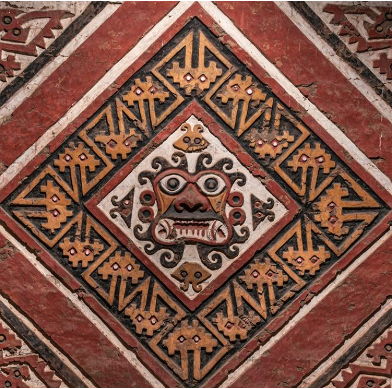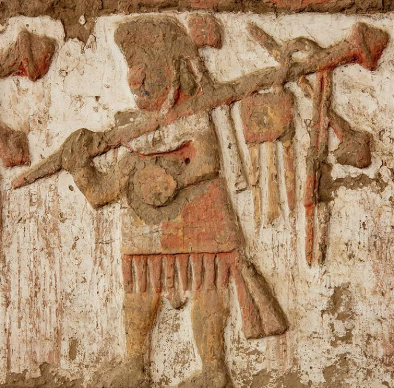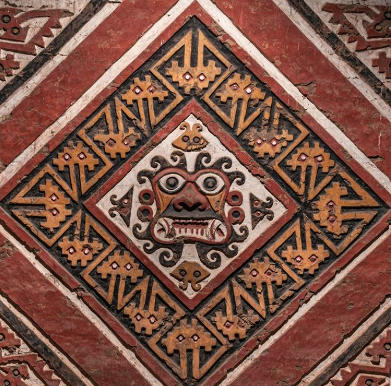
The Moche built the Huaca de la Luna and Huaca del Sol, which are examples of how advanced the early civilizations of Peru were in their building techniques, art and ceramics.
These were ceremonial structures for the ancient Moche culture built, in the Moche Valley as part of the ancient capital city called Cerro Blanco.
Moche culture

The Moche culture flourished from around 100 AD to 800 AD, and at its height they built some monumental cities and temple structures. Little is known about the Moche as they had no written language, and what is known has been interpreted from their art and ceramics which show scenes from their lives of hunting, fishing, fighting, sacrifice and elaborate ritual ceremonies.
Their cities, ceremonial centers and temples were made of mud brick and in my eyes were most impressive. Tours out of Trujillo take you to both. The Huaca del Sol was the largest of all the buildings on the site and thought to be the largest pre-Columbian structure in Peru, but the Spanish actually diverted a river and destroyed 2/3rds of the temple looking for gold and other treasure.
Huaca del Sol and Huaca de la Luna

What remains still stands magnificent against the blue sky. The archaeologists believe that Huaca del Sol was used mainly for administrative purposes and the burial of the rulers. Huaca de la Luna fared a little better, though. I imagine that it was because it was built up the side of a mountain called Cerro Blanco and thus not so easily ravaged.
Still, a portion of the pyramid has been destroyed by looters and so most work by archaeologists is being done on the central and Southern platforms. This temple is where religious ceremonies like the Warrior Narrative were performed and it housed the religious elite and their burials. From the top of these platforms are dramatic views of the ancient city as it is being investigated by archaeologists and the fertile Moche Valley and River.
Structure of temples
The Moche like the Maya did not tear down their temples as they did new construction. They simply built over the old one making it larger but leaving the exterior of the old one intact and therefore preserving a lot of the art work and colors that covered them. On the outer walls of the older temples you can see paintings, murals and sculptured reliefs with their colors still intact.
Murals and sculpted reliefs portraying spiders, fish, dragons, dogs, warriors and their captives can still be seen at this site. I can’t imagine how much fear, reverence and awe these temples must have inspired at the height of this culture in both the population and captives being brought into the city. They practiced human sacrifice and it was performed around a formation of stone that was sacred to the Moche.
Human sacrifice

A portion of the temple was actually built around this stone. When the area was excavated there were hundreds of decapitated skeletons found here. Art from ceramic pieces (called the Warrior Narrative) found at other sites gives a glimpse into the ceremony that was performed here. It is conjectured that captive warriors either had their skulls crushed, their throats slit or were decapitated and then their bodies thrown from the temple platform into this area containing the sacred stone formation.
Their primary god Ai-Apaec (Ayapec) is often referred to “The Decapitator” because he is depicted in a lot of their art when the full body is shown holding a decapitated head. The vast majority of representations of their god are of his head only. Ai-Apaec is actually a pre-Quechua word translated as “All Knowing.” The art on the walls of the temple reminded me of Egypt in a way.
The temples were covered in paintings depicting their gods and the things that were important to them. There were also scenes of soldiers and their captives that looked almost identical to the paintings on the tombs of some of the Pharos of Egypt. During the tour of this temple you will see many bricks with different marks on them. It is thought that the ruling and religious elite required that a certain number of bricks be made by the different clans that made up the population and these marks were a way for them to account for the number supplied.
The Moche thrived for many centuries but eventually their culture came to an end. Archaeologists named the Moche people and culture after the primary archaeological site in the Moche River Valley. The latest theory holds that they were not conquered by another culture but succumbed to climatic changes and an internal war for scarce resources. Some also theorize that the Moche culture evolved into the Chimu which built the amazing city of Chan Chan.
Preserving the past

The World Monument Fund has been doing a lot of work to help preserve this site. This is easily observed by the multitude of coverings built over the structures to prevent further erosion by the rains. In addition to the rains, the blowing sand has caused much damage to this site and fence type structures have been put up to keep back the sand and help prevent erosion by wind and blowing sand also.
I personally think that the remnants of all the ancient cultures are worth saving and studying. We have lost so much knowledge of our past. Some of it we will never recover and are only now coming to the realization of how important this past can be to us. All peoples should take pride in their ancient heritage and do whatever they can to help protect and preserve it.